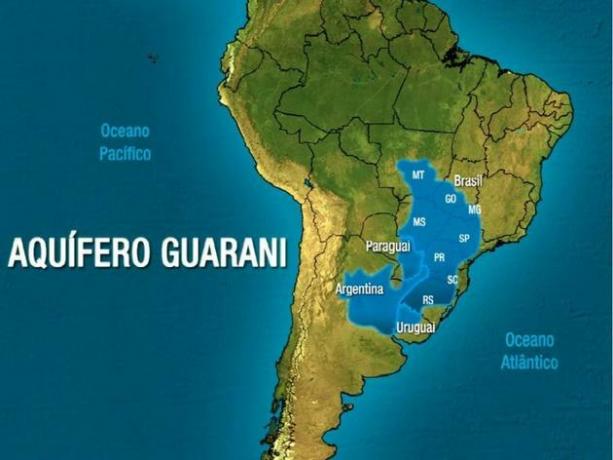O Guarani Aquifer or Guarani Aquifer System (SAG) represents the second largest source of fresh underground water on the planet and occupies an area of 1.2 million km2.
It received this name in 1996, as the region where it is located is associated with the territory where part of the Guaraní Indians lived.
Features
With an approximate depth of 1500 meters, this large underground water reservoir (volume approximately 45 thousand km3) is located in southern South America.
In size, the Guarani Aquifer is second only to the Alter do Chão Aquifer, in the northern region of the country.
Its waters cover four countries: Brazil (840,000 km2), Argentina (225,500 km2), Paraguay (71,700 km2) and Uruguay (58,500 km2).

About 2/3 of the Guarani aquifer area is located in the central-southwest region of Brazil. See below the size of the aquifer in each Brazilian state:
- Goiás (55,000 km2)
- Mato Grosso (26,400 km2)
- Mato Grosso do Sul (213,200 km2)
- Minas Gerais (51,300 km2)
- São Paulo (155. 800 km2)
- Paraná (131,300 km2)
- Santa Catarina (49,200 km2)
- Rio Grande do Sul (157,600 km2)
Importance
Aquifers are of great environmental importance, as they maintain a balance between the amount of groundwater and surface water on the planet.
The Guarani Aquifer has great economic and social importance, as it supplies the region in which it is located, thus collaborating with its development.
The territory in which it is located encompasses a population of approximately 15 million inhabitants and about 200 Brazilian cities that use their water for supply.
Formation

The Guarani Aquifer, consisting of sandy sediments (sandstone) and basalt lavas, was formed in the Mesozoic Era (241 million to 65 million years ago). In an aquifer, rock and water form part of the same structure.
Its geological formation, with porous and impermeable rocks, contributed to the absorption and storage of rainwater catchment. Through rainfall and rivers, aquifers continue to have their water replenished.
Environmental problems
The pollution of the place has been one of the biggest problems faced and discussed by environmentalists. With the expansion of urbanization and industrialization in aquifer areas, soil contamination has affected water quality.
Soil preservation is essential, as crops such as eucalyptus leave the soil impermeable and make it difficult for rainwater to pass through. It is estimated that an area planted with these trees only allows 9% of the water to pass through. On the other hand, a pasture area allows for 26% absorption.
Likewise, it seeks to raise awareness among the local population against the waste of water.
Recent studies point to the importance of its preservation, such as the “Guarani Aquifer System Environmental Protection and Sustainable Development Project” (2003-2009), created in partnership with countries where the aquifer is present.
With the union and cooperation of the four countries, this project aims to improve the management of water resources as well as implement environmental protection actions in the aquifer areas.
The issue of preservation remains on the agenda, so that in 2010 the four countries signed an agreement to expand the cooperation of common interests.
Privatization
In 2016, false news circulated that the Guarani Aquifer would be privatized, as it would be sold to large food multinationals.
In 2017 and 2018, the rumor circulated again due to the presentation of a bill by Senator Tasso Jereissati (PSDB/CE).
The project foresaw the negotiation of use rights in case of scarcity, maintaining the priority for the consumption of people and animals.
This proposition did not foresee the privatization of water, which is a resource owned by the Brazilian State, as well as any sale of the aquifer or other water source.
Even the companies involved (Coca Cola and Nestlé) issued a clarification note about this.
It should be said that the Guarani Aquifer is located in four countries and any decision will have to be taken together, at the risk of affecting relations between them.
Brazilian Aquifers
In addition to the Guarani Aquifer, in Brazil there are about 25 aquifers, of which the following stand out:
- Alter do Chão Aquifer
- Bauru Aquifer
- Botucatu Aquifer
- Serra Geral Aquifer
- Aquifer Heads
- Urucuia-Areado Aquifer
- Furnas Aquifer
- karst aquifer
- Hamza aquifer
- Itapecuru Aquifer
read more:
- Groundwater
- World Water Day
- Hydrosphere
- Potable water
- Enem geography: subjects that fall the most
